Electric light
An electric light is a device that produces visible light from electric current. It is the most common form of artificial lighting and is essential to modern society,[1] providing interior lighting for buildings and exterior light for evening and nighttime activities. In technical usage, a replaceable component that produces light from electricity is called a lamp.[2] Lamps are commonly called light bulbs; for example, the incandescent light bulb.[3] Lamps usually have a base made of ceramic, metal, glass, or plastic, which secures the lamp in the socket of a light fixture. The electrical connection to the socket may be made with a screw-thread base, two metal pins, two metal caps or a bayonet cap.
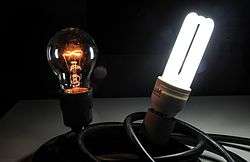
The three main categories of electric lights are incandescent lamps, which produce light by a filament heated white-hot by electric current, gas-discharge lamps, which produce light by means of an electric arc through a gas, and LED lamps, which produce light by a flow of electrons across a band gap in a semiconductor.
Before electric lighting became common in the early 20th century, people used candles, gas lights, oil lamps, and fires.[4] English chemist Humphry Davy developed the first incandescent light in 1802, followed by the first practical electric arc light in 1806. By the 1870s, Davy's arc lamp had been successfully commercialized, and was used to light many public spaces.[5] Efforts by Swan and Edison led to commercial incandescent light bulbs becoming widely available in the 1880s, and by the early twentieth century these had completely replaced arc lamps.[1][4]
The energy efficiency of electric lighting has increased radically since the first demonstration of arc lamps and the incandescent light bulb of the 19th century. Modern electric light sources come in a profusion of types and sizes adapted to many applications. Most modern electric lighting is powered by centrally generated electric power, but lighting may also be powered by mobile or standby electric generators or battery systems. Battery-powered light is often reserved for when and where stationary lights fail, often in the form of flashlights or electric lanterns, as well as in vehicles.
Types

Types of electric lighting include:
- Incandescent light bulb, a heated filament inside a glass envelope
- Halogen lamps are incandescent lamps that use a fused quartz envelope filled with halogen gas
- LED lamp, a solid-state lamp that uses light-emitting diodes (LEDs) as the source of light
- Arc lamp
- Xenon arc lamp
- Mercury-xenon arc lamp
- Ultra-high-performance lamp, an ultra-high-pressure mercury-vapor arc lamp for use in movie projectors
- Metal-halide lamp
- Gas-discharge lamp, a light source that generates light by sending an electric discharge through an ionized gas
- Fluorescent lamp
- Compact fluorescent lamp, a fluorescent lamp designed to replace an incandescent lamp
- Neon lamp
- Mercury-vapor lamp
- Sodium-vapor lamp
- Sulfur lamp
- Electrodeless lamp, a gas discharge lamp in which the power is transferred from outside the bulb to inside via electromagnetic fields
- Fluorescent lamp
Different types of lights have vastly differing efficacies and color of light.[6]
| Name | Optical spectrum | Nominal efficacy (lm/W) | Lifetime (MTTF) (hours) | Color temperature (kelvin) | Color | Color rendering index |
|---|---|---|---|---|---|---|
| Incandescent light bulb | Continuous | 4–17 | 2–20,000 | 2,400–3,400 | Warm white (yellowish) | 100 |
| Halogen lamp | Continuous | 16–23 | 3,000–6,000 | 3,200 | Warm white (yellowish) | 100 |
| Fluorescent lamp | Mercury line + Phosphor | 52–100 (white) | 8,000–20,000 | 2,700–5,000* | White (various color temperatures), as well as saturated colors available | 15–85 |
| Metal-halide lamp | Quasi-continuous | 50–115 | 6,000–20,000 | 3,000–4,500 | Cold white | 65–93 |
| Sulfur lamp | Continuous | 80–110 | 15,000–20,000 | 6,000 | Pale green | 79 |
| High pressure sodium | Broadband | 55–140 | 10,000–40,000 | 1,800–2,200* | Pinkish orange | 0–70 |
| Low pressure sodium | Narrow line | 100–200 | 18,000–20,000 | 1,800* | Yellow, no color rendering | 0 |
| LED lamp | Line plus phosphor | 10–110 (white) | 50,000–100,000 | Various white from 2,700 to 6,000* | Various color temperatures, as well as saturated colors | 70–85 (white) |
| Electrodeless lamp | Mercury line + Phosphor | 70–90 (white) | 80,000–100,000 | Various white from 2,700 to 6,000* | Various color temperatures, as well as saturated colors | 70–85 (white) |
*Color temperature is defined as the temperature of a black body emitting a similar spectrum; these spectra are quite different from those of black bodies.
The most efficient source of electric light is the low-pressure sodium lamp. It produces, for all practical purposes, a monochromatic orange-yellow light, which gives a similarly monochromatic perception of any illuminated scene. For this reason, it is generally reserved for outdoor public lighting applications. Low-pressure sodium lights are favoured for public lighting by astronomers, since the light pollution that they generate can be easily filtered, contrary to broadband or continuous spectra.
Incandescent light bulb
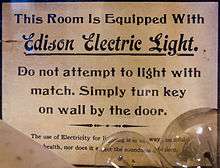
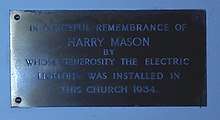
The modern incandescent light bulb, with a coiled filament of tungsten, and commercialized in the 1920s, developed from the carbon filament lamp introduced about 1880. As well as bulbs for normal illumination, there is a very wide range, including low voltage, low-power types often used as components in equipment, but now largely displaced by LEDs
Incandescent bulbs are being phased out in many countries due to their low energy efficiency. Less than 3% of the input energy is converted into usable light. Nearly all of the input energy ends up as heat that, in warm climates, must then be removed from the building by ventilation or air conditioning, often resulting in more energy consumption. In colder climates where heating and lighting is required during the cold and dark winter months, the heat byproduct has at least some value.
Halogen lamp
Halogen lamps are usually much smaller than standard incandescent lamps, because for successful operation a bulb temperature over 200 °C is generally necessary. For this reason, most have a bulb of fused silica (quartz) or aluminosilicate glass. This is often sealed inside an additional layer of glass. The outer glass is a safety precaution, to reduce ultraviolet emission and to contain hot glass shards should the inner envelope explode during operation. Oily residue from fingerprints may cause a hot quartz envelope to shatter due to excessive heat buildup at the contamination site. The risk of burns or fire is also greater with bare bulbs, leading to their prohibition in some places, unless enclosed by the luminaire.
Those designed for 12- or 24-volt operation have compact filaments, useful for good optical control. Also, they have higher efficacies (lumens per watt) and better lives than non-halogen types. The light output remains almost constant throughout their life.
Fluorescent lamp
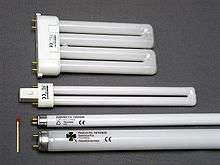
Fluorescent lamps consist of a glass tube that contains mercury vapour or argon under low pressure. Electricity flowing through the tube causes the gases to give off ultraviolet energy. The inside of the tubes are coated with phosphors that give off visible light when struck by ultraviolet photons.[7] They have much higher efficiency than incandescent lamps. For the same amount of light generated, they typically use around one-quarter to one-third the power of an incandescent. The typical luminous efficacy of fluorescent lighting systems is 50–100 lumens per watt, several times the efficacy of incandescent bulbs with comparable light output. Fluorescent lamp fixtures are more costly than incandescent lamps, because they require a ballast to regulate the current through the lamp, but the lower energy cost typically offsets the higher initial cost. Compact fluorescent lamps are available in the same popular sizes as incandescent lamps and are used as an energy-saving alternative in homes. Because they contain mercury, many fluorescent lamps are classified as hazardous waste. The United States Environmental Protection Agency recommends that fluorescent lamps be segregated from general waste for recycling or safe disposal, and some jurisdictions require recycling of them.[8]
LED lamp

The solid-state light-emitting diode (LED) has been popular as an indicator light in consumer electronics and professional audio gear since the 1970s. In the 2000s, efficacy and output have risen to the point where LEDs are now being used in lighting applications such as car headlights and brake lights, in flashlights and bicycle lights, as well as in decorative applications, such as holiday lighting. Indicator LEDs are known for their extremely long life, up to 100,000 hours, but lighting LEDs are operated much less conservatively, and consequently have shorter lives. LED technology is useful for lighting designers, because of its low power consumption, low heat generation, instantaneous on/off control, and in the case of single color LEDs, continuity of color throughout the life of the diode and relatively low cost of manufacture. LED lifetime depends strongly on the temperature of the diode. Operating an LED lamp in conditions that increase the internal temperature can greatly shorten the lamp's life.
Carbon arc lamp
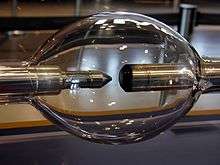
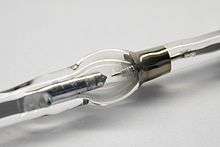
Carbon arc lamps consist of two carbon rod electrodes in open air, supplied by a current-limiting ballast. The electric arc is struck by touching the rod tips then separating them. The ensuing arc produces a white-hot plasma between the rod tips. These lamps have higher efficacy than filament lamps, but the carbon rods are short-lived and require constant adjustment in use, as the intense heat of the arc erodes them. The lamps produce significant ultraviolet output, they require ventilation when used indoors, and due to their intensity they need protection from direct sight.
Invented by Humphry Davy around 1805, the carbon arc was the first practical electric light. It was used commercially beginning in the 1870s for large building and street lighting until it was superseded in the early 20th century by the incandescent light. Carbon arc lamps operate at high power and produce high intensity white light. They also are a point source of light. They remained in use in limited applications that required these properties, such as movie projectors, stage lighting, and searchlights, until after World War II.
Discharge lamp
A discharge lamp has a glass or silica envelope containing two metal electrodes separated by a gas. Gases used include, neon, argon, xenon, sodium, metal halide, and mercury. The core operating principle is much the same as the carbon arc lamp, but the term "arc lamp" normally refers to carbon arc lamps, with more modern types of gas discharge lamp normally called discharge lamps. With some discharge lamps, very high voltage is used to strike the arc. This requires an electrical circuit called an igniter, which is part of the electrical ballast circuitry. After the arc is struck, the internal resistance of the lamp drops to a low level, and the ballast limits the current to the operating current. Without a ballast, excess current would flow, causing rapid destruction of the lamp.
Some lamp types contain a little neon, which permits striking at normal running voltage, with no external ignition circuitry. Low pressure sodium lamps operate this way. The simplest ballasts are just an inductor, and are chosen where cost is the deciding factor, such as street lighting. More advanced electronic ballasts may be designed to maintain constant light output over the life of the lamp, may drive the lamp with a square wave to maintain completely flicker-free output, and shut down in the event of certain faults.
Form factors
Many lamp units, or light bulbs, are specified in standardized shape codes and socket names. Incandescent bulbs and their retrofit replacements are often specified as "A19/A60 E26/E27", a common size for these kind of light bulbs. In this example, the "A" parameters describe the bulb size and shape while the "E" parameters describe the Edison screw base size and thread characteristics.
Lamp life expectancy
Life expectancy for many types of lamp is defined as the number of hours of operation at which 50% of them fail, that is the median life of the lamps. Production tolerances as low as 1% can create a variance of 25% in lamp life, so in general some lamps will fail well before the rated life expectancy, and some will last much longer. For LEDs, lamp life is defined as the operation time at which 50% of lamps have experienced a 70% decrease in light output.
Some types of lamp are also sensitive to switching cycles. Rooms with frequent switching, such as bathrooms, can expect much shorter lamp life than what is printed on the box. Compact fluorescent lamps are particularly sensitive to switching cycles.
Public lighting
The total amount of artificial light (especially from street light) is sufficient for cities to be easily visible at night from the air, and from space. This light is the source of light pollution that burdens astronomers and others.

Uses other than illumination
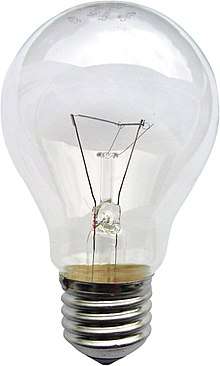
Electric lamps can be used as heat sources, for example in incubators, as infrared lamps in fast food restaurants and toys such as the Kenner Easy-Bake Oven.
Due to their nonlinear resistance characteristics, tungsten filament lamps have long been used as fast-acting thermistors in electronic circuits. Popular uses have included:
- Stabilization of sine wave oscillators
- Protection of tweeters in loudspeaker enclosures; excess current that is too high for the tweeter illuminates the light rather than destroying the tweeter.
- Automatic volume control in telephones
A stylized depiction of a light bulb features as the logo of the Turkish AK Party.[9][10]
Circuit symbols
In circuit diagrams lamps usually are shown as symbols. There are two main types of symbols, these are:
 The cross in a circle usually represents a lamp as an indicator. (ANSI/IEEE Std 315A-1986)
The cross in a circle usually represents a lamp as an indicator. (ANSI/IEEE Std 315A-1986) The semicircular dent in a circle, which usually represents a lamp as a source of light or illumination.
The semicircular dent in a circle, which usually represents a lamp as a source of light or illumination.
See also
- Light tube
- List of light sources
References
- Reisert, Sarah (2015). "Let there be light". Distillations Magazine. 1 (3): 44–45. Retrieved 22 March 2018.
- "Lamp". Dictionary.com. Retrieved November 9, 2014.
- "Light bulb". Merriam-Webster. Retrieved September 18, 2017.
- Freebert, Ernest (2014). The age of Edison : electric light and the invention of modern America. Penguin Books. ISBN 978-0-14-312444-3.
- Guarnieri, M. (2015). "Switching the Light: From Chemical to Electrical" (PDF). IEEE Industrial Electronics Magazine. 9 (3): 44–47. doi:10.1109/MIE.2015.2454038.CS1 maint: ref=harv (link)
- Brown, Martin T. (2003) Memorandum from Martin T Brown. UK Parliament
- Perkowitz, Sidney; Henry, A. Joseph (23 November 1998). Empire of Light:: A History of Discovery in Science and Art. Joseph Henry Press. ISBN 978-0-309-06556-6.
- United States Environmental Protection Agency, OSWER (2015-07-23). "Hazardous Waste". US EPA. Retrieved 3 November 2018.
- Thomson Reuters (2013-06-29). "A protester holds a light bulb, the official symbol of Turkey's ruling AK Party (AKP), with a Nazi swastika sign painted on it during an anti-government protest at Taksim Square in Istanbul". news.trust.org. Retrieved 2018-11-03.
- Kutlugun, Satuk Bugra and Akcay, Ahmet Sait (14 August 2016). "15 years of Turkey's Justice and Development Party". Anadolu Agency.CS1 maint: multiple names: authors list (link)